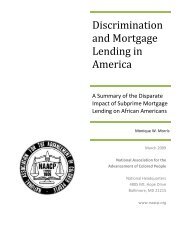TOOLKIT
TOOLKIT
TOOLKIT
Create successful ePaper yourself
Turn your PDF publications into a flip-book with our unique Google optimized e-Paper software.
EDUCATION<br />
The promise of quality education is an important civil and human right that<br />
has yet to be fully realized in the American education system. African<br />
Americans are more likely to attend high-poverty schools and are less<br />
likely to graduate from high school, and subsequently attend college, at<br />
rates lower than any other racial group. With that knowledge, it is<br />
important that all students, especially for students of color, to emerge<br />
from school with an understanding of the environment.<br />
The intersections between education and<br />
environment include toxic exposures which affect<br />
learning, asthma exacerbated by environment,<br />
which affects school attendance/participation,<br />
toxic facility placement which affects property<br />
values which finance schools, and the deferment<br />
of school schedules impacted by disasters, must<br />
be understood and addressed through policy,<br />
structure, and programs.<br />
It is critical that there is robust curriculum content on the environment and climate change in our<br />
education system as pathways for our leadership on issues that disproportionately affect us. For<br />
example, as we anticipate the way climate change will increasingly impact the Earth and our<br />
communities and as we seek to play a leadership role in climate change mitigation and<br />
adaptation, we must ensure that there is a critical mass of students of color in the environmental<br />
sciences pipeline who are prepared for leadership roles.<br />
Why Environmental ARTivism and Internships?<br />
Along with learning the hard science behind the environmental and climate justice issues, it is<br />
important to make learning fun and interactive. Education should be about involving different<br />
media and what better way to support a multisensory education than through the arts – dance,<br />
music, painting, sculpture, and theater. This is an opportunity to make environmental and<br />
climate justice issues something more tangible – we can give the community something they<br />
can feel, hear, smell, and see.<br />
Internships give you the opportunity to take what you are feeling, hearing, smelling, seeing and<br />
learning in the classroom and transition your education into skills that will be transferable in the<br />
work place. Environmental internships are also a mechanism for enhancing the Black-Green<br />
pipeline.<br />
36 | P a g e








